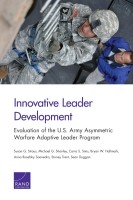| 来源类型 | Research Reports
|
| 规范类型 | 报告
|
| DOI | https://doi.org/10.7249/RR504
|
| ISBN | 9780833087492
|
| 来源ID | RR-504-A
|
| Innovative Leader Development: Evaluation of the U.S. Army Asymmetric Warfare Adaptive Leader Program |
| Susan G. Straus; Michael G. Shanley; Carra S. Sims; Bryan W. Hallmark; Anna Rosefsky Saavedra; Stoney Trent; Sean Duggan
|
| 发表日期 | 2014
|
| 出版年 | 2014
|
| 页码 | 164
|
| 语种 | 英语
|
| 结论 |
Students Felt They Benefited from the Program- Students were extremely satisfied with the course structure, content, and delivery of the Asymmetric Warfare Adaptive Leader Program (AWALP).
- Students not only sensed a change in their own capabilities and interests about adaptive performance but appeared to see their work contexts in a different light.
- Results show substantial improvement in attitudes about adaptive performance even after accounting for students' characteristics that are associated with adaptiveness.
AWALP Was Successful at Fostering Knowledge Gain for a Wide Range of Students- Students demonstrated increased knowledge of adaptive performance concepts.
- Students showed improved knowledge regardless of other characteristics associated with test performance, including general cognitive ability and level of education.
Team Adaptiveness Was Favorable Overall, but There Were Discrepancies Between Guides' and Students' Ratings- In general, both students and guides (instructors) gave favorable ratings of team adaptive performance.
- However, students consistently gave higher ratings of team performance than guides did and appeared to become more confident about the level of adaptiveness in their teams as the course progressed.
Graduates Reported Applying What They Learned After Returning to Their Units- Graduates reported substantial application of AWALP principles on the job, especially in the areas of coaching, training, delegating to subordinates, and seeking subordinate input.
- Graduates reported more successful dissemination of AWALP principles to subordinates than to peers and commanders.
- Graduates remained positive about AWALP training but found command climate and entrenched leadership the biggest obstacles to applying adaptive performance principles.
|
| 摘要 |
- Put more emphasis on anticipating and responding to potential challenges to implementing program principles on the job.
- Enhance the curriculum by reinforcing important team-level concepts (e.g., mutual monitoring and backup behavior) and by providing instruction about the relationships among inputs to the team, throughputs, and team outcomes.
- Conduct systematic behavioral observations during the course to further evaluate individual and team adaptive performance.
- Assess transfer of training by measuring the association of performance in AWALP with subsequent job performance.
|
| 主题 | Asymmetric Warfare
; Educational Program Evaluation
; Military Education and Training
; Organizational Leadership Development
|
| URL | https://www.rand.org/pubs/research_reports/RR504.html
|
| 来源智库 | RAND Corporation (United States)
|
| 引用统计 |
|
| 资源类型 | 智库出版物
|
| 条目标识符 | http://119.78.100.153/handle/2XGU8XDN/107877
|
推荐引用方式
GB/T 7714 |
Susan G. Straus,Michael G. Shanley,Carra S. Sims,et al. Innovative Leader Development: Evaluation of the U.S. Army Asymmetric Warfare Adaptive Leader Program. 2014.
|
|
文件名:
|
x1536860859630.jpg
|
|
格式:
|
JPEG
|

|
文件名:
|
RAND_RR504.pdf
|
|
格式:
|
Adobe PDF
|
除非特别说明,本系统中所有内容都受版权保护,并保留所有权利。